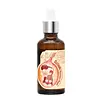What's inside
What's inside
 Key Ingredients
Key Ingredients

 Benefits
Benefits

 Concerns
Concerns

No concerns
 Ingredients Side-by-side
Ingredients Side-by-side

Bifida Ferment Lysate
Skin ConditioningButylene Glycol
HumectantBifida Ferment Filtrate
Skin ConditioningLactobacillus Ferment Lysate
Skin ConditioningLactococcus Ferment Lysate
Skin ConditioningSaccharomyces Ferment Filtrate
HumectantGlycerin
HumectantNiacinamide
Smoothing1,2-Hexanediol
Skin ConditioningLactobacillus/Pumpkin Fruit Ferment Filtrate
Skin ConditioningAureobasidium Pullulans Ferment
Skin ConditioningHyaluronic Acid
HumectantSodium Hyaluronate
HumectantSodium Hyaluronate Crosspolymer
HumectantSodium Acetylated Hyaluronate
HumectantHydrolyzed Sodium Hyaluronate
Skin ConditioningPotassium Hyaluronate
Skin ConditioningHydrolyzed Hyaluronic Acid
HumectantHydroxypropyltrimonium Hyaluronate
Leontopodium Alpinum Callus Culture Extract
AntioxidantCutibacterium Granulosum Ferment Extract Filtrate
EmollientAsiaticoside
AntioxidantAsiatic Acid
Skin ConditioningMadecassic Acid
Skin ConditioningPentylene Glycol
Skin ConditioningSqualane
EmollientHydrogenated Lecithin
EmulsifyingCopper Tripeptide-1
Skin ConditioningTromethamine
BufferingAcetyl Hexapeptide-8
HumectantPropanediol
SolventEthylhexylglycerin
Skin ConditioningDextrin
AbsorbentWater
Skin ConditioningCaffeine
Skin ConditioningBenzyl Glycol
SolventSodium Phytate
Hydrolyzed Algin
Xanthan Gum
EmulsifyingEpigallocatechin Gallate
AntioxidantCarbomer
Emulsion StabilisingPhysalis Alkekengi Calyx Extract
Skin ConditioningHydrolyzed Glycosaminoglycans
HumectantPolyglyceryl-10 Laurate
Skin ConditioningTheobroma Cacao Seed Extract
AntioxidantAdenosine
Skin ConditioningBifida Ferment Lysate, Butylene Glycol, Bifida Ferment Filtrate, Lactobacillus Ferment Lysate, Lactococcus Ferment Lysate, Saccharomyces Ferment Filtrate, Glycerin, Niacinamide, 1,2-Hexanediol, Lactobacillus/Pumpkin Fruit Ferment Filtrate, Aureobasidium Pullulans Ferment, Hyaluronic Acid, Sodium Hyaluronate, Sodium Hyaluronate Crosspolymer, Sodium Acetylated Hyaluronate, Hydrolyzed Sodium Hyaluronate, Potassium Hyaluronate, Hydrolyzed Hyaluronic Acid, Hydroxypropyltrimonium Hyaluronate, Leontopodium Alpinum Callus Culture Extract, Cutibacterium Granulosum Ferment Extract Filtrate, Asiaticoside, Asiatic Acid, Madecassic Acid, Pentylene Glycol, Squalane, Hydrogenated Lecithin, Copper Tripeptide-1, Tromethamine, Acetyl Hexapeptide-8, Propanediol, Ethylhexylglycerin, Dextrin, Water, Caffeine, Benzyl Glycol, Sodium Phytate, Hydrolyzed Algin, Xanthan Gum, Epigallocatechin Gallate, Carbomer, Physalis Alkekengi Calyx Extract, Hydrolyzed Glycosaminoglycans, Polyglyceryl-10 Laurate, Theobroma Cacao Seed Extract, Adenosine
 Reviews
Reviews

Ingredients Explained
These ingredients are found in both products.
Ingredients higher up in an ingredient list are typically present in a larger amount.
1,2-Hexanediol is a synthetic liquid and another multi-functional powerhouse.
It is a:
- Humectant, drawing moisture into the skin
- Emollient, helping to soften skin
- Solvent, dispersing and stabilizing formulas
- Preservative booster, enhancing the antimicrobial activity of other preservatives
Adenosine is in every living organism. It is one of four components in nucleic acids that helps store our DNA.
Adenosine has many benefits when used. These benefits include hydrating the skin, smoothing skin, and reducing wrinkles. Once applied, adenosine increases collagen production. It also helps with improving firmness and tissue repair.
Studies have found adenosine may also help with wound healing.
In skincare products, Adenosine is usually derived from yeast.
Learn more about AdenosineBifida ferment filtrate is derived from the fermentation of Bifida bacteria (often with dairy). It is a probiotic and helps to strengthen our skin's microbiome.
Carbomer is a polymer of acrylic acid. Its main role is to create a gel consistency.
A high amount of carbomer can cause pilling or balling up of products. Don't worry, most products contain 1% or less of carbomer.
Niacinamide is a multitasking form of vitamin B3 that strengthens the skin barrier, reduces pores and dark spots, regulates oil, and improves signs of aging.
And the best part? It's gentle and well-tolerated by most skin types, including sensitive and reactive skin.
You might have heard of "niacin flush", or the reddening of skin that causes itchiness. Niacinamide has not been found to cause this.
In very rare cases, some individuals may not be able to tolerate niacinamide at all or experience an allergic reaction to it.
If you are experiencing flaking, irritation, and dryness with this ingredient, be sure to double check all your products as this ingredient can be found in all categories of skincare.
When incorporating niacinamide into your routine, look out for concentration amounts. Typically, 5% niacinamide provides benefits such as fading dark spots. However, if you have sensitive skin, it is better to begin with a smaller concentration.
When you apply niacinamide to your skin, your body converts it into nicotinamide adenine dinucleotide (NAD). NAD is an essential coenzyme that is already found in your cells as "fuel" and powers countless biological processes.
In your skin, NAD helps repair cell damage, produce new healthy cells, support collagen production, strengthen the skin barrier, and fight environmental stressors (like UV and pollution).
Our natural NAD levels start to decline with age, leading to slower skin repair, visible aging, and a weaker skin barrier. By providing your skin niacinamide, you're recharging your skin's NAD levels. This leads to stronger, healthier, and younger looking skin.
Another name for vitamin B3 is nicotinamide. This vitamin is water-soluble and our bodies don't store it. We obtain Vitamin B3 from either food or skincare. Meat, fish, wheat, yeast, and leafy greens contain vitamin B3.
The type of niacinamide used in skincare is synthetically created.
Learn more about Niacinamide